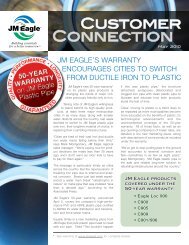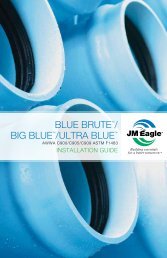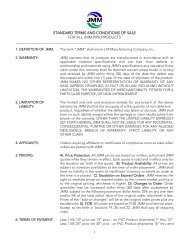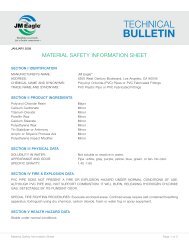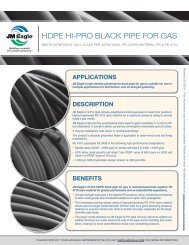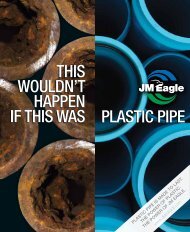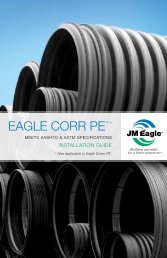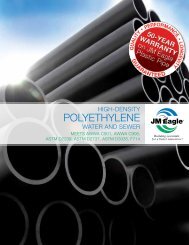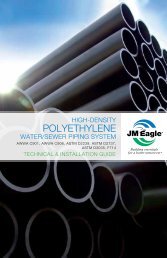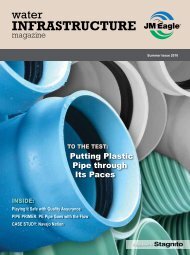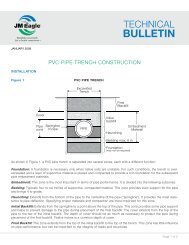lick here - JM Eagle
lick here - JM Eagle
lick here - JM Eagle
Create successful ePaper yourself
Turn your PDF publications into a flip-book with our unique Google optimized e-Paper software.
PVC VS. POLYPROPYLENE (PP) SEWER PIPE<br />
PVC: PROVEN PERFORMANCE MAKES IT THE RIGHT CHOICE<br />
PP Pipe Doesn’t Measure Up: The recent introduction of PP into the sanitary sewer market should be cause for concern<br />
to wastewater utilities. Unsupported claims about performance, lack of rigorous studies and testing, questions<br />
regarding joint integrity, reduced safety factor, limited selection of fittings for connections, all point to the need to<br />
exercise caution when considering PP alternatives over PVC pipe.<br />
Choose PVC Pipe: Today’s sewer utilities require piping products with a proven track record of performance. Supported<br />
by over 40 years of standards and testing, PVC pipe offers exceptional joint integrity, low maintenance,<br />
and a high safety factor, backed by stringent mandrel and low-pressure air tests. With a broad assortment of fittings<br />
for connections, which help avoid compromising system integrity through use of cut-in fittings, PVC pipe is<br />
available in a wide array of options suitable for the most difficult applications.<br />
Property<br />
ASTM D3034 & ASTM F794 ASTM F949 ASTM F1803 ASTM F2736 ASTM F2764<br />
F679<br />
Material PVC PVC PVC PVC PP PP<br />
Year Approved 1972 1983 1985 1997 2010 2010<br />
Tensile Min. 6000 psi 6000 psi 6000 psi 6000 psi 3500 psi 3500 psi<br />
Modulus Min. 440,000 psi 440,000 psi 440,000 psi 440,000 psi 175,000 psi 175,000 psi<br />
Pipe Stiffness Min.<br />
46 46 46 46 46 46<br />
@ 23° C / 73° F<br />
Pipe Stiffness @ 40° C / 104° F 40 40 40 40 Not Stated Not Stated<br />
Impact Resistance* 220 ft-lbf 220 ft-lbf 140 ft-lbf 220 ft-lbf 140 ft-lbf 140 ft-lbf<br />
Air Test N/A Yes No Yes No No<br />
Minimum Wall** 0.853 0.235 0.130 0.150 0.108 0.070<br />
Manning “N” 0.009 0.009 0.009 0.009 0.012 0.012<br />
Flattening 60% 40% 40% 40% 20% 40%<br />
Recommend Max.<br />
Diameter Deflection<br />
7.5% 7.5% 7.5% 7.5% None Given None Given<br />
Deflection Before Buckling 30+% 30+% 3.43 x<br />
(OD/OD-ID)<br />
Unspecified Unspecified Unspecified<br />
Base ID Specified Unspecified Specified Unspecified Unspecified Unspecified<br />
7.5% Mandrel Specified Unspecified Specified Unspecified Unspecified Unspecified<br />
Fittings<br />
Joints<br />
Full Line; Multiple<br />
Sources<br />
Meet ASTM<br />
D3212<br />
Full Line; Multiple<br />
Sources<br />
Meet ASTM<br />
D3212<br />
Full Line; Multiple<br />
Sources<br />
Meet ASTM<br />
D3212<br />
Full Line; Multiple<br />
Sources<br />
Meet ASTM<br />
D3212<br />
Single-Source<br />
Bells Require<br />
Stiffeners<br />
Single-Source<br />
Bells Require<br />
Stiffeners<br />
* Per pipe standard when tested using ASTM D2444 apparatus (10” & larger).<br />
** Minimum waterway wall (inner wall) thickness for the 30” trade size.<br />
ASTM D3034-08: Standard Specifi cation for Type PSM Poly (Vinyl Chloride) (PVC) Sewer Pipe and Fittings<br />
ASTM F679-08: Standard Specification for Poly (Vinyl Chloride) (PVC) Large-Diameter Plastic Gravity Sewer Pipe and Fittings<br />
ASTM F794-03: Standard Specification for Poly (Vinyl Chloride) (PVC) Profile Gravity Sewer Pipe and Fittings Based on Controlled Inside Diameter<br />
ASTM F949-10: Poly (Vinyl Chloride) (PVC) Corrugated Sewer Pipe with a Smooth Interior and Fittings<br />
ASTM F1803-06: Standard Specification for Poly (Vinyl Chloride) (PVC) Closed Profile Gravity Pipe and Fittings Based on Controlled Inside Diameter<br />
ASTM F2736-10: Standard Specification for 6 to 30 in. (152 To 762 mm) Polypropylene (PP) Corrugated Single Wall Pipe and Double Wall Pipe<br />
ASTM F2764-10: Standard Specification for 30 to 60 in. (750 to 1500 mm) Polypropylene (PP) Triple Wall Pipe and Fittings for Non-Pressure Sanitary Sewer Applications<br />
Uni-Bell PVC Pipe Association | 2711 LBJ Freeway, Suite 1000 | Dallas, TX 75234<br />
Phone: (972) 243-3902 | Fax: (972) 243-3907 | info@uni-bell.org
PVC VS. POLYPROPYLENE (PP) SEWER PIPE<br />
PVC: PROVEN PERFORMANCE MAKES IT THE RIGHT CHOICE<br />
With more than one million miles in service, PVC pipe has been used for sanitary sewers for over 40 years,<br />
offering cost effectiveness and proven performance. Available in sizes up to 60 inches, it is used in over<br />
85% of new installations. Specified in 87% of the 100 largest cities in North America, its design, quality control<br />
testing, ease of installation and maintenance make it the material of choice for sanitary sewers.<br />
PVC PVC Pipe – Long-Term Performance You Can Trust: Over four decades of unsurpassed reliability in sanitary sewer applications<br />
backed by PVC sewer pipe standards that include: ASTM D2729 (1968), ASTM D3034 (1972), ASTM F679 (1980), ASTM F794 (1983), and<br />
ASTM F949 (1985).<br />
Exceptional Joint Integrity & Abrasion Resistance: PVC sewer pipe systems meet the most stringent joint tightness standard: 25<br />
gallons/inch of diameter/mile/day as specified by Uni-Bell’s Handbook of PVC Pipe. This reduces groundwater infiltration, conserving<br />
costly treatment plant capacity, decreases sewage exfiltration, protecting public health and the environment, and prevents root<br />
intrusion, lowering maintenance costs. PVC is extremely tough, and its abrasion resistance has been confirmed by numerous studies<br />
and years of service. Condition assessments, including video and laser profiling, have shown PVC sewer pipe remains sound after<br />
decades of service.<br />
Quality Assurance Through Stringent Acceptance Tests: PVC sewer pipe systems conform to stringent design criteria. Quality<br />
acceptance tests for PVC pipe systems, including mandrel and low-pressure air acceptance testing (UNI-B-06, ASTM F1417), help<br />
ensure long-term performance. Uni-Bell recommends these tests for all pipe materials.<br />
Mandrel Testing – PVC Pipe Ensures a High Safety Factor: The PVC pipe industry and ASTM have long recommended mandrels<br />
that allow no more than 7-1/2% deflection of the PVC pipe diameter – which provides an installation safety factor of 4:1. Several PVC<br />
sewer pipe standards, like ASTM D3034, ASTM F679, and ASTM F949, include test mandrel diameters. Unlike PVC, pipes with lower<br />
deflection capacities such as profile-wall PP must specify lower deflection levels to ensure the same degree of safety.<br />
Most Widely Used Air Test: Low-pressure air testing should apply to all sanitary sewer line installations. Uni-Bell’s Recommended<br />
Practice for Air Acceptance Testing of Sewer Pipe, Standard UNI-B-06 has become the industry benchmark as a result of testing and research<br />
done since the 1950s. ASTM also provides material-specific standards for low-pressure air testing of sewer systems, including<br />
ASTM C828, ASTM C924, and ASTM F1417. While none measure up to UNI-B-06 for ensuring system tightness, ASTM F1417 is the most<br />
widely used of ASTM’s low-pressure air testing standards. PP, on the other hand, has a lower modulus and lower resistance to creep, so<br />
standard low-pressure air testing may not give adequate assurance of long-term joint tightness. Further study of PP is needed to validate<br />
its long-term joint integrity.<br />
Proven Final Verification: Utilities often specify minimum waiting periods of 30 days before performing final verification of newly<br />
installed PVC sewer pipes. This deflection-versus-time testing is a proven method of ensuring proper design and installation of PVC<br />
pipe systems – borne out by over 40 years of research and field experience. Until comparable testing is completed for PP pipe, to confirm<br />
joint integrity and ad<strong>here</strong>nce to specified deflection limits, users should not assume that mandrel and low-pressure air tests provide<br />
the same assurance of installation quality as they do for PVC.<br />
Maximize System Integrity with PVC Fittings: Unlike PP systems, PVC sewer pipe comes with a wide assortment of fittings available<br />
from many manufacturers: elbows, tees, wyes, reducers, etc. Joints using PVC fittings meet the same high performance requirements,<br />
since pipe joints and systems can easily be designed without the need for fittings that require cutting holes into the<br />
pipe, ultimately compromising system integrity. Maximum sanitary sewer system watertightness is achieved by avoiding cut-in fittings<br />
whenever possible.<br />
PVC for Challenging Design Applications: For difficult installations — w<strong>here</strong> deep burial, poor soils, high water tables, and high<br />
drag-down forces due to settlement are factors — PVC pipe offers heavy-wall higher-stiffness pipe, as well as higher-stiffness and<br />
deep-socket fittings, which is not the case for PP.<br />
Uni-Bell PVC Pipe Association | 2711 LBJ Freeway, Suite 1000 | Dallas, TX 75234<br />
Phone: (972) 243-3902 | Fax: (972) 243-3907 | info@uni-bell.org



